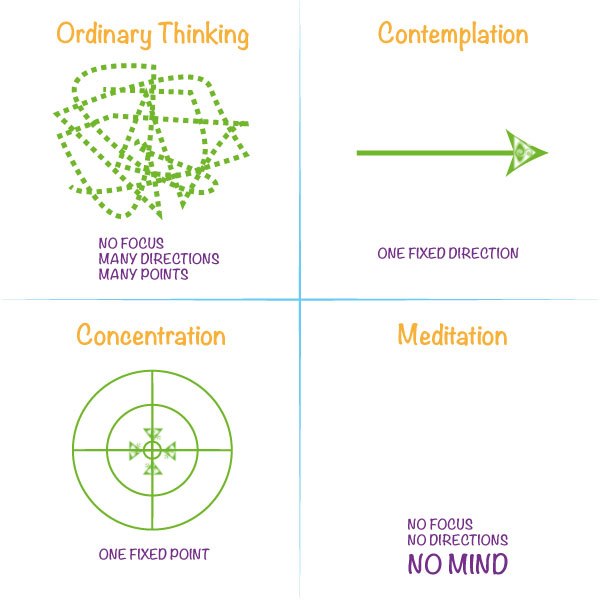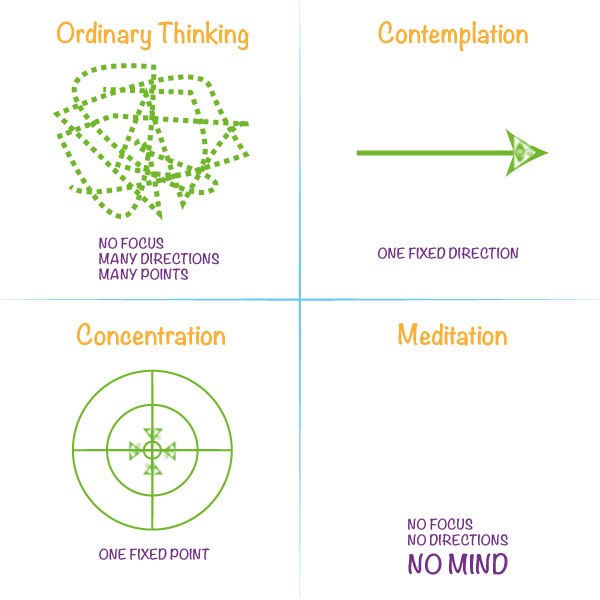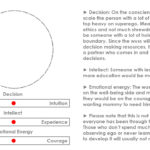‘Contemplation’ means directed thinking. We all think; that is not contemplation. That thinking is undirected, vague, leading nowhere. Really, our thinking is not contemplation, but what Freudians call association. One thought leads to another without any direction from you. The thought itself leads to another because of association.
You see a dog crossing the street. The moment you see the dog, your mind starts thinking about dogs. The dog has led you to this thought, and then the mind has many associations. When you were a child, you were afraid of a particular dog. That dog comes to the mind and then the childhood comes to the mind. Then dogs are forgotten; then just by association you begin to daydream about your childhood. Then the childhood goes on being connected with other things, and you move in circles.
Amazon #ads

Whenever you are at ease, try to go backwards from your thinking to where the thoughts came from. Go back, retrace the steps. Then you will see that another thought was there, and that led to this. And they are not logically connected, because how is a dog on the street connected with your childhood?
There is no logical connection – only association in your mind. If I was crossing the street, the same dog would not lead me to my childhood, it would lead to something else. In a third person it would lead to still something else. Everyone has associated chains in the mind. With any one person some happening, some accident will lead to the chain. Then the mind begins to function like a computer. Then one thing leads to another, another leads to another, and you go on, and the whole day you are doing that.

Write down on a sheet of paper whatsoever comes to your mind, honestly. You will be just amazed what is happening in your mind. There is no relation between two thoughts, and you go on doing this type of thinking. You call this thinking? This is just association of one thought with another, and they lead themselves… you are led.
Thinking becomes contemplation when it moves not through association, but is directed. You are working on a particular problem – then you bracket out all associations. You move on that problem only, you direct your mind. The mind will try to escape to any bypath, to any side route, to some association. You cut off all the side routes; on only one road you direct your mind. A scientist working on a problem is in contemplation. A logician working on a problem, a mathematician working on a problem is in contemplation. A poet contemplates a flower. Then the whole world is bracketed out, and only that flower and the poet remains, and he moves with the flower. Many things from side routes will attract, but he does not allow his mind to move anywhere. Mind moves in one line, directed. This is contemplation.
Science is based on contemplation. Any logical thinking is contemplation: thought is directed, thinking guided. Ordinary thinking is absurd. Contemplation is logical, rational.
Then there is ‘concentration’. Concentration is staying at one point. It is not thinking; it is not contemplation. It is really being at one point, not allowing the mind to move at all. In ordinary thinking mind moves as a madman. In contemplation the madman is led, directed; he cannot escape anywhere.
In concentration the mind is not allowed to move. In ordinary thinking, it is allowed to
move anywhere; in contemplation, it is allowed to move only somewhere; in concentration, it is not allowed to move, it is only allowed to be at one point. The whole energy, the whole movement stops, sticks to one point. Yoga is concerned with concentration, ordinary mind with undirected thinking, the scientific mind with directed thinking. The yogic mind has its thinking focused, fixed at one point; no movement is
allowed.
Amazon #ads

And then there is ’meditation’. In ordinary thinking, mind is allowed to move anywhere; in
contemplation, it is allowed only in one direction, all other directions are cut off. In concentration, it is not allowed to move even in one direction; it is allowed only to concentrate on one point. And in meditation, mind is not allowed at all. Meditation is no-mind.
These are four stages: ordinary thinking, contemplation, concentration, meditation.
Meditation means no-mind – not even concentration is allowed. Mind itself is not allowed to be! That is why meditation cannot be grasped by mind. Up to concentration mind has a reach, an approach. Mind can understand concentration, but mind cannot understand meditation. Really, mind is not allowed at all. In concentration, mind is allowed to be at one point. In meditation, even that point is taken away. In ordinary thinking, all directions are open. In contemplation, only one direction is open. In concentration, only one point is open – no direction. In meditation, even that point is not open: mind is not allowed to be. Ordinary thinking is the ordinary state of mind, and meditation is the highest possibility. The lowest one is ordinary thinking, association, and the highest, the peak, is meditation – no-mind.




